Beavers moved into town. Even a large city like Cedar Rapids.
Surprise
An amazing sight greeted us In December 2024, as we walked a circular trail around a tiny unnamed stream in the heart of Cedar Rapids, Iowa. A beaver dam spanned the narrow waterway. Beaver-felled trees lined the bank while bark-peeled branches floated in the still water.
Nearby were two busy roads, houses, and apartment buildings. Tall downtown buildings were just a mile away. So were factories. These beavers are urban.
- Cedar Lake, Cedar Rapids, Iowa.
- A beaver chew next to urban stream.
Urban Beavers
Beavers in a city of 140,000 people! 100 years ago, no one would have imagined that beavers moved into town. But today North America’s largest rodent has moved into cities across the continent. They thrive despite noise and human activity.
Watching City Beavers
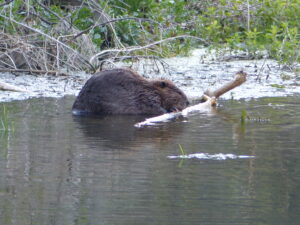
Chewiing
Lots of people enjoy urban birding, and beaver-watching is just as fun. Their territory is easy to find. Fetch a lawn chair, dress warmly, bring binoculars, and perch within sight of beaver activity in the early morning or late afternoon when they’re likely most active.
What to Look For
No animal leaves such visible and durable calling cards as does a beaver family. We walk trails along rivers and often spot trees felled by the sharp teeth and powerful jaw muscles of ambitious beavers. They relish eating the thin nutritious bark covering branches. Beavers leave so much debris around it’s hard to miss finding an active colony.
- chips
- Beavers slide
While waiting for beavers to appear keep your eyes peeled. Beavers are a keystone species that alters its environment by cutting trees, digging den holes in the bank, and backing up streams. Their activity attracts many other species, including muskrats, mink, and a host of songbirds that frequent the water’s edge.
An Amazing Resurgence Follows Sad Exploitation
When early Europeans crossed the Atlantic, they found a beaver-filled continent. Experts guess there were somewhere between 60 million and 400 million of the furry animals from coast to coast. That soon changed. European beavers had been hunted and trapped for ages and weren’t common, so newly arrived Americans almost immediately began trapping the huge rodents.
Legendary mountain men combed the Rockies to find plentiful beavers and hundreds of thousands of pelts were shipped eastward in canoes by Canadian voyageurs. Many were shipped to Europe. In the days before synthetic insulation fur kept people warm, and fashionable beaver hats were made from their hair.
Decline and Ethics
The fur trade lasted about 250 years until the late 1800s when the animals had been extirpated from vast parts of their original range. Then came happier news. The value of beaver pelts sank as hats went out of fashion, trees rebounded along streams, and new conservation laws and ethics arose. That started a slow comeback, and now beavers seem to be everywhere.
Two Species
There are two beaver species – the North American and Eurasian. Both are similar but the Old-World species is slightly larger. Each species has made a dramatic comeback. American beavers were released in Finland and Patagonia, where they now thrive as invasive species.
Where Are the Beaver Dams?
Children love reading books about beavers and know that they build dams. Well, not always. These ambitious animals are smart. If their pond, lake, or river is deep enough there’s no need to build a dam. They simply tunnel into the bank to create a home or, sometimes, build a dome-shaped house of sticks and mud that’s usually easy to spot.
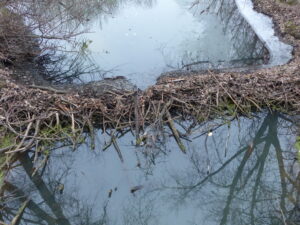
Crossing a small stream.
However, if their stream is narrow and shallow beavers spend nights changing it. They’ll build an amazingly sturdy and often long dam spanning the stream, creating water deep enough for good swimming and hiding a bank tunnel entrance below the surface. Beavers are engineers.
Easy to Watch Urban Beavers
Years ago, beavers were hard to find, even in rural areas. Not anymore. They’re so common in urban areas that people can enjoy them without making a long drive.

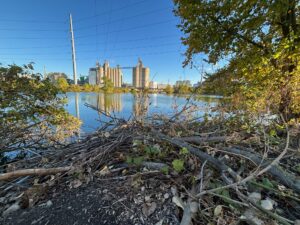
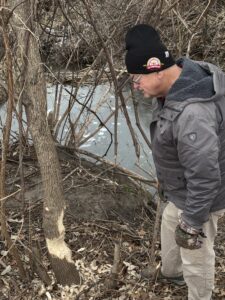
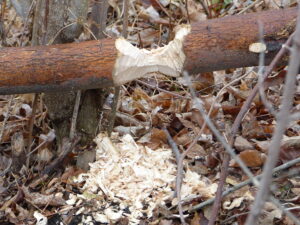
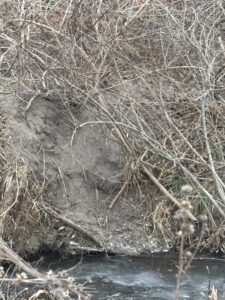

Used to see beavers on Indian Creek not far from your house.
Beavers are at the Prairie Park Fishery also.
There was a beaver dam in the same place about 20 years ago.
thanks, Ann! Always interesting how nature cycles around. M~